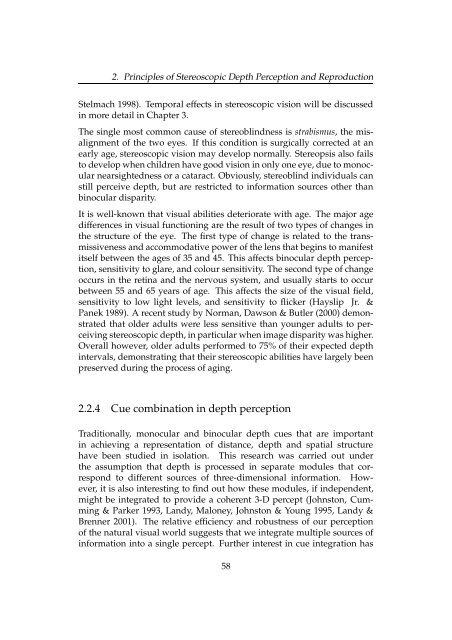Chapter 2 Principles of Stereoscopic Depth Perception and ...
Chapter 2 Principles of Stereoscopic Depth Perception and ...
Chapter 2 Principles of Stereoscopic Depth Perception and ...
Create successful ePaper yourself
Turn your PDF publications into a flip-book with our unique Google optimized e-Paper software.
2. <strong>Principles</strong> <strong>of</strong> <strong>Stereoscopic</strong> <strong>Depth</strong> <strong>Perception</strong> <strong>and</strong> Reproduction<br />
Stelmach 1998). Temporal effects in stereoscopic vision will be discussed<br />
in more detail in <strong>Chapter</strong> 3.<br />
The single most common cause <strong>of</strong> stereoblindness is strabismus, the misalignment<br />
<strong>of</strong> the two eyes. If this condition is surgically corrected at an<br />
early age, stereoscopic vision may develop normally. Stereopsis also fails<br />
to develop when children have good vision in only one eye, due to monocular<br />
nearsightedness or a cataract. Obviously, stereoblind individuals can<br />
still perceive depth, but are restricted to information sources other than<br />
binocular disparity.<br />
It is well-known that visual abilities deteriorate with age. The major age<br />
differences in visual functioning are the result <strong>of</strong> two types <strong>of</strong> changes in<br />
the structure <strong>of</strong> the eye. The first type <strong>of</strong> change is related to the transmissiveness<br />
<strong>and</strong> accommodative power <strong>of</strong> the lens that begins to manifest<br />
itself between the ages <strong>of</strong> 35 <strong>and</strong> 45. This affects binocular depth perception,<br />
sensitivity to glare, <strong>and</strong> colour sensitivity. The second type <strong>of</strong> change<br />
occurs in the retina <strong>and</strong> the nervous system, <strong>and</strong> usually starts to occur<br />
between 55 <strong>and</strong> 65 years <strong>of</strong> age. This affects the size <strong>of</strong> the visual field,<br />
sensitivity to low light levels, <strong>and</strong> sensitivity to flicker (Hayslip Jr. &<br />
Panek 1989). A recent study by Norman, Dawson & Butler (2000) demonstrated<br />
that older adults were less sensitive than younger adults to perceiving<br />
stereoscopic depth, in particular when image disparity was higher.<br />
Overall however, older adults performed to 75% <strong>of</strong> their expected depth<br />
intervals, demonstrating that their stereoscopic abilities have largely been<br />
preserved during the process <strong>of</strong> aging.<br />
2.2.4 Cue combination in depth perception<br />
Traditionally, monocular <strong>and</strong> binocular depth cues that are important<br />
in achieving a representation <strong>of</strong> distance, depth <strong>and</strong> spatial structure<br />
have been studied in isolation. This research was carried out under<br />
the assumption that depth is processed in separate modules that correspond<br />
to different sources <strong>of</strong> three-dimensional information. However,<br />
it is also interesting to find out how these modules, if independent,<br />
might be integrated to provide a coherent 3-D percept (Johnston, Cumming<br />
& Parker 1993, L<strong>and</strong>y, Maloney, Johnston & Young 1995, L<strong>and</strong>y &<br />
Brenner 2001). The relative efficiency <strong>and</strong> robustness <strong>of</strong> our perception<br />
<strong>of</strong> the natural visual world suggests that we integrate multiple sources <strong>of</strong><br />
information into a single percept. Further interest in cue integration has<br />
58


